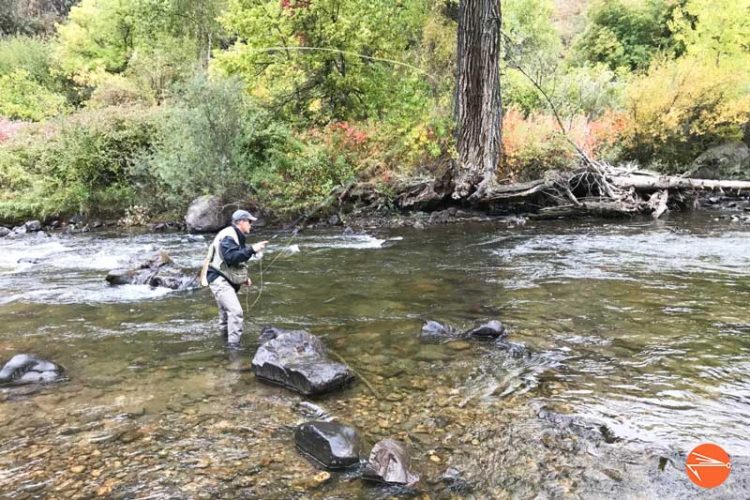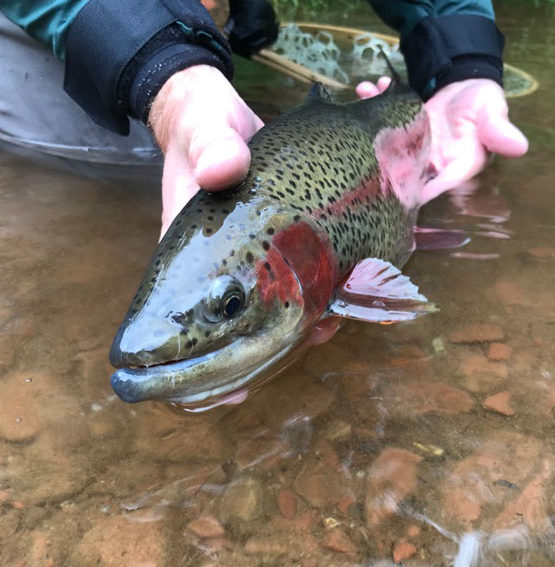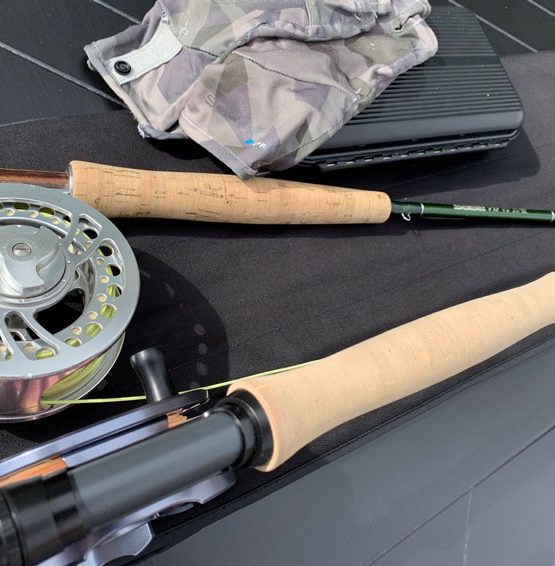When it comes to fly fishing, using the proper casting technique for each situation can make or break your success. In fact, as most experienced anglers will agree, your presentation is the most important aspect of fly fishing–and it all begins with the right cast.
That’s exactly why, for the rest of this guide, we’re going to explore seven of the most important fly casting techniques that you, and every other angler, should learn.
And while I realize that there are more than 7 ways to cast a fly rod, in my experience, these particular techniques will get you through almost any fly fishing situation you ever encounter.
Let’s get started!
1. The Roll Cast
The roll cast is one of the most essential techniques to learn if you plan to do any small stream fishing or you ever run into a tight-quarter casting situation.
In most cases, it is one of the first techniques you should learn as an angler, as you will use it on a regular basis.
The good news is that it is one of the easier techniques to learn, and it can save you from all sorts of casting trouble in a variety of situations.
Whether you need to stay clear of branches or brush in your back cast, you don’t have any room for a backcast at all, or you just need to land your fly in a very precise location, this cast can help.
To execute the Roll Cast, simply lift your rod high (to lift the majority of your line off the water) and push it forward with a snap of the wrist.
When done properly, your line should “roll” out over itself, eventually sending your rig flying forward.
With no backcast and very little fly rod movement, the roll cast both reduces the risk of tangles and allows you to drop your fly into some seemingly impossible locations.
Seriously, the roll cast is one of the most important techniques you can add to your fly fishing repertoire.
You Might Also Like:
- How To Cast In The Wind: 7 Simple Tips
- 21 Common Fly Fishing Mistakes To Avoid
- 9 Killer Nymphing Tips For Beginners
- What To Wear Fly Fishing: The Angler’s Apparel Guide
- 10 Best Places To Buy Fly Fishing Gear Online
- 25 Proven Tips To Catch More Trout
- Is Fly Fishing Hard To Learn?
2. The Water Haul Cast
If you do a lot of river fishing and you want to avoid tangles and snags, then the water haul cast is one of the most important fly casting techniques for you to learn.
To execute the water haul, follow these 4 steps:
- Allow your rig to float downstream to the very end of your drift.
- Lift your fly rod until your casting hand is approximately shoulder-height.
- Turn your palm upwards, look upstream, and identify your casting target.
- Utilizing the tension of the water that’s pulling your rig downstream (kind of like pulling back a loaded sling-shot), cast your rod upstream. As an added note, try to point your rod exactly where you want your rig to land. Also, be sure to cast with some authority, as you need to put enough power in your cast to break the surface tension between your line and the water.
In most cases, by using the power of the water, you’ll be able to cast further (and with more precision) than a traditional cast.
Like the roll cast, the water haul is a great technique because you don’t need to worry about false casting.
It can also help you generate a higher line speed, making it easier for you to throw heavy flies and weighted rigs further, even in the wind.
To be honest, I probably use the water haul 75% of the time when I’m nymphing. It’s just so wonderfully simple and effective!
3. The Tuck Cast
The tuck cast is a very useful method for nymph fishing, as it allows your flies to sink quickly.
It is simple to perform, although it will take a little practice.
To start, make a normal forward cast. But just as the line is starting to straighten, slightly lift the tip of your rod.
This will cause your rig to drop beneath your fly line and straight down into the water. Thus, your flies will hit the water before your line and sink more quickly. Additionally, the tuck cast will allow your flies just enough slack to start drifting as naturally as possible from the moment they enter the water.
Like a few of the other fly casting techniques in this post, the tuck cast will take a bit of practice to master. But with a little dedication, it can significantly improve your nymphing success.
4. The Sidearm Cast
The sidearm cast is perfect for tight casting situations where you have cover overhead or are casting from the side of a shrouded stream.
Also, because the sidearm cast keeps your line closer to the water, it can significantly reduce the effects of drag in windy conditions.
While it might not be as technical as the Roll Cast or Water Haul, it is one of the most useful casting techniques you can learn as an angler. If you are planning on fishing in tight or windy conditions, the sidearm cast is perfect.
5. The Double-Haul
While many types of casts can do well in the wind, few are as effective as the double-haul cast.
Plus, when it is performed correctly it will put much less strain on your arms and shoulders while simultaneously increasing your cast length and accuracy. This may seem a little contradictory, but you will be amazed at how much power and control the double-haul can give you.
The double-haul cast is essentially a normal overhead cast with some fancy line management in your non-casting hand.
To execute the double-haul, follow these steps:
- Using your casting hand, pull your rod back exactly as you would for a normal overhead cast while simultaneously pulling downward on your slack with your non-casting hand. (This pulling motion is the 1st haul in a double-haul cast.)
- As your line unfurls in your backcast, bring your non-casting hand (while still holding your fly line) toward your fly rod to get ready for the second haul.
- When you transition into your forward cast, simultaneously pull down on your slack again. This will add a little extra power (i.e. line speed) to your cast, allowing you to cast further and/or punch your line through windy conditions.
- Finish your cast by pointing the tip of your rod at your casting target, and letting go of the slack in your non-casting hand.
Of all the techniques in this guide, the double-haul and the triple-haul (more on that later) are definitely the most difficult to learn. They require quite a bit more coordination than a traditional overhead cast.
However, once you learn how to cast the double-haul, you’ll probably never go back.
I mean, you’ll just have so much control over your fly rod, you won’t know what to do with yourself!
6. The Immediate Mend Cast
This casting technique involves mending your fly line the moment it hits the water.
Mending is the action of properly positioning your fly line while your flies are in the water in order to improve your drift and overall presentation.
And remember, the better the presentation, the more likely you are to get a bite.
To perform this casting technique, start by making a normal overhead cast (or double-haul if you’ve graduated from the school of casting techniques that make you look cool).
Then, the moment your flies hit the water, flick the tip of your rod upstream so that your line lands upstream of your flies.
When done correctly, the immediate mend cast eliminates the need for a mend later in your drift when the slightest change in presentation can send the fish swimming.
Just like other casting techniques on our list, you probably won’t master this one on your first try. But if you’re willing to practice and get good at this fly casting technique, you’ll be amazed at the kind of fish-catching results it can bring about.
7. The Triple-Haul
As you might suspect, the triple-haul cast is essentially the same exact cast as the double-haul, but with one extra haul.
In fact, to execute the triple-haul, all you have to do is make a double-haul cast, and then pull back on your slack one more time, just as your line unfurls over the water.
This third haul will help speed up the final moment in your cast and drop your rig right where you need it.
Thus, the triple-haul is fantastic when you need the maximum amount of control on windy days.
Like the double-haul, this casting technique can be a little tricky to get the hang of, but with a little practice you can quickly master it.
Actually, come to think of it, once you learn the double-haul, the triple-haul is a pretty easy addition!
Final Thoughts
There is a fly casting technique for just about every situation you can imagine.
But among all the techniques out there, I can confidently say that these 7 will get you through thick and thin. Whether you need to sling a heavy nymph rig with the Water Haul, navigate a tight-quarter casting situation with a Roll Cast, or punch your rig through the wind using a double- or triple-haul, the sooner you learn these techniques, the more fish you will catch.
Now get out on the water and start practicing. Oh, and if there are any other casting techniques that you feel should have made this list, be sure to drop them in the comments!
Disclaimer: This post may contain affiliate links, meaning we will receive a small commission (at no cost to you) if you click through and make a purchase.









